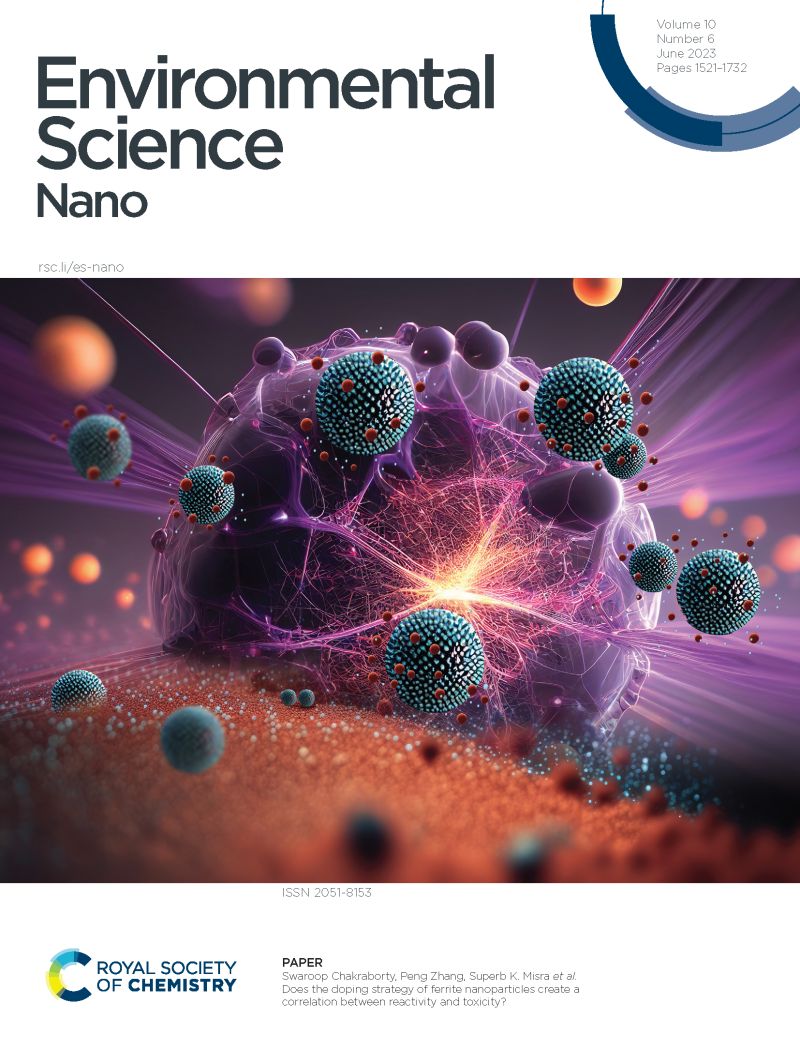定量生物脂(鼠李糖脂)对工程纳米颗粒聚集行为的影响
IF 5.1
2区 环境科学与生态学
Q1 CHEMISTRY, MULTIDISCIPLINARY
引用次数: 0
摘要
预测水系统中纳米级材料的稳定性对于准确模拟颗粒在环境中的命运和运输至关重要。这种稳定性不仅是粒子表面化学和离子强度和类型的函数,而且还可以受到常见的水性成分的强烈影响,包括天然有机物质(NOM)、蛋白质、脂质以及其他大分子。其中,生物表面活性剂,当存在时,被假设在纳米颗粒的稳定性、流动性和最终命运方面起着重要的界面作用。具体来说,鼠李糖脂(鼠李糖脂是一些最常见的天然生物表面活性剂)的作用尚不清楚。为了解决这一知识空白,研究人员在铜绿假单胞菌分泌的两种两亲性糖脂——单hamol脂(monoRL)和双hamol脂(diRL)存在的情况下,评估了具有阳离子和阴离子表面化学性质的8 nm单分散氧化铁(nano)颗粒(IONPs)的聚集动力学。结果表明,离子表面电荷、RL类型(即单脂与双糖脂)和浓度决定了离子的稳定性。此外,水化学(考虑单价和二价离子)在这些过程和结果中起着关键作用。高浓度的RLs (CMCmonoRL = 20.9, CMCdiRL = 10.1 mg OC/L以上)对阴离子离子有较强的吸附作用。在dil的存在下,阴离子离子的临界凝血浓度(CCC)从700 mM增加到1500 mM。RLs还能强烈吸附表面带正电荷的离子离子(浓度为<;CMC)。带正电荷的IONPs在单orl和diRL的中等浓度(~CMC)下聚集,然后由于(NP)表面RL双层的形成,在较高浓度(1.5 - 2 CMC)下有效地重新稳定。对于RL涂层的离子,确定了三种不同的聚集机制,作为电解质浓度(1-2000 mM)的函数,其中带正电荷的离子不遵循典型的基于dlvo的粒子相互作用理论。本文章由计算机程序翻译,如有差异,请以英文原文为准。
Quantifying Biolipid (Rhamnolipid) Effects on the Aggregation Behavior of Engineered Nanoparticles
Predicting nanoscale material stability in aqueous systems is essential to accurately model particle fate and transport in the environment. Such stability is not only a function of particle surface chemistry and ionic strength and type, but can also be strongly affected by common aqueous constituents including natural organic matter (NOM), proteins, and lipids, among other macromolecules. Of these, biological surfactants, when present, have been hypothesized to play a significant, interfacial role with regard to nanoparticle stability, mobility and thus ultimate fate. Specifically, the role(s) of rhamnolipid(s), which are some of the most common naturally occurring biosurfactants, remains unclear. To address this knowledge gap, aggregation dynamics of 8 nm monodispersed iron oxide (nano)particles (IONPs) with cationic and anionic surface chemistries were evaluated in presence of monorhamnolipid (monoRL) and dirhamnolipid (diRL), two amphiphilic glycolipids excreted by Pseudomonas aeruginosa, among other bacteria. Results demonstrate that IONP surface charge, RL type (i.e. mono- vs. dirhamnolipid), and concentration govern particle stability. Further, water chemistry (considering monovalent and divalent ions) plays a key role in these processes and outcomes. RLs at higher concentrations (above CMCmonoRL = 20.9, CMCdiRL = 10.1 mg of OC/L) adsorbed strongly on anionic IONPs. For these, the critical coagulation concentration (CCC) of anionic IONPs increased from 700 mM to 1500 mM in the presence of DiRL. RLs also strongly sorbs on IONP with a positive surface charge (at concentrations < CMC). Positively charged IONPs aggregated at intermediate concentrations (~CMC) of monoRL and diRL, and then effectively re-stabilized at higher concentrations (1.5 – 2 CMC) due to (NP) surface RL bilayer formation. For RL coated IONPs, three distinct aggregation regimes were identified as a function of electrolyte concentration (1-2000 mM), for which positively charged IONPs do not follow typical DLVO-based particle interaction theory.
求助全文
通过发布文献求助,成功后即可免费获取论文全文。
去求助
来源期刊

Environmental Science: Nano
CHEMISTRY, MULTIDISCIPLINARY-ENVIRONMENTAL SCIENCES
CiteScore
12.20
自引率
5.50%
发文量
290
审稿时长
2.1 months
期刊介绍:
Environmental Science: Nano serves as a comprehensive and high-impact peer-reviewed source of information on the design and demonstration of engineered nanomaterials for environment-based applications. It also covers the interactions between engineered, natural, and incidental nanomaterials with biological and environmental systems. This scope includes, but is not limited to, the following topic areas:
Novel nanomaterial-based applications for water, air, soil, food, and energy sustainability
Nanomaterial interactions with biological systems and nanotoxicology
Environmental fate, reactivity, and transformations of nanoscale materials
Nanoscale processes in the environment
Sustainable nanotechnology including rational nanomaterial design, life cycle assessment, risk/benefit analysis
 求助内容:
求助内容: 应助结果提醒方式:
应助结果提醒方式:


